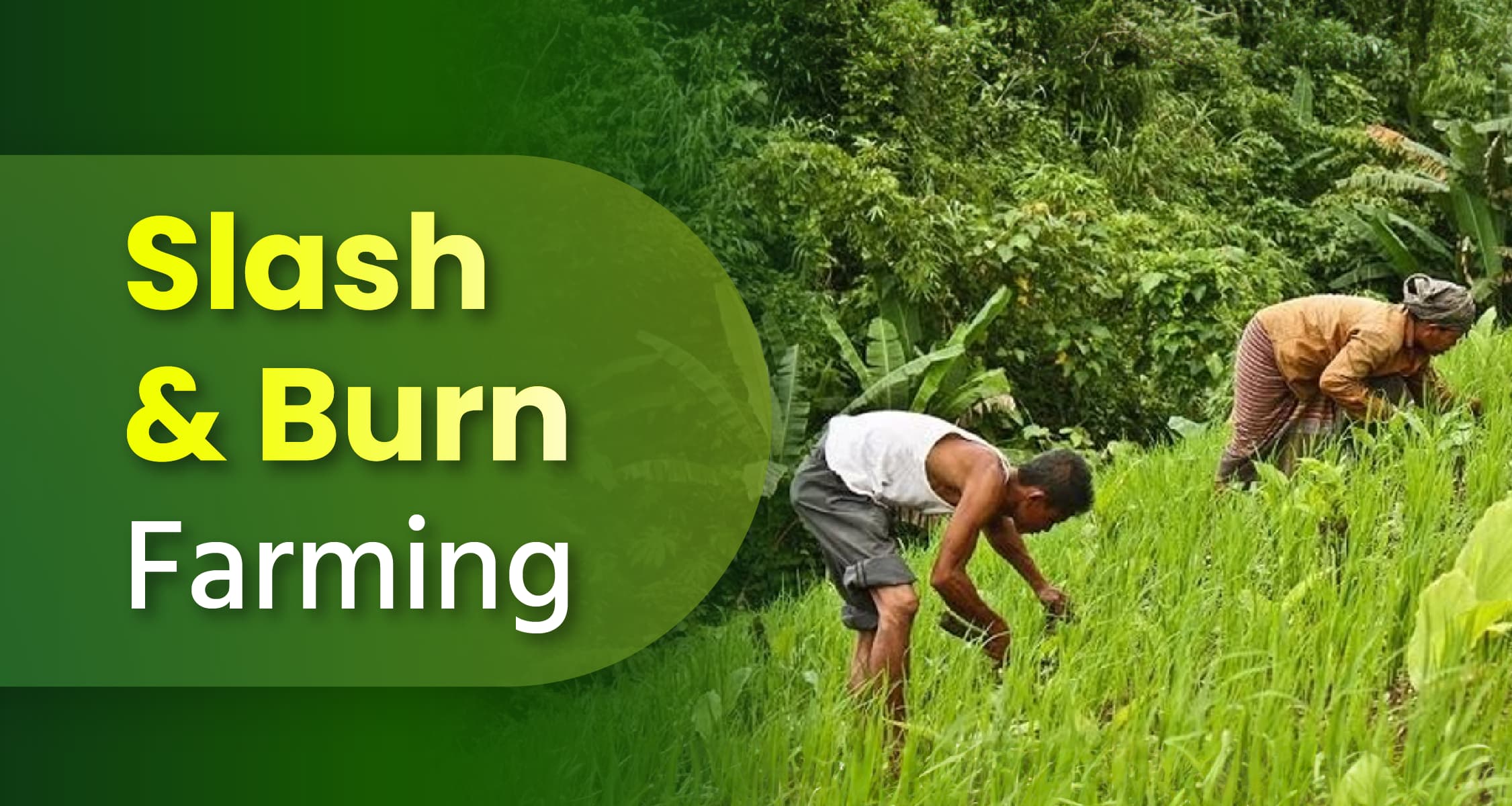Slash & Burn Farming (Jhum Farming)

Jhum Agriculture, also known as slash-and-burn farming, is a traditional agricultural practice where trees are cut down and burned to clear the land. Afterward, old agricultural tools are used to till the soil and seeds are sown. This land is cultivated until the soil fertility is exhausted. Once the fertility is depleted, the land is abandoned, and a new area is cleared by burning vegetation to prepare fresh agricultural land. This process is why it is referred to as shifting cultivation.
How to do Slash-and-Burn Farming?
- Land Clearing: The first step in the farming process is to clear the land by removing trees, shrubs, and vegetation. This is essential as it prepares the area for new crops and makes the land suitable for farming.
- Burning Vegetation: During May and June, the existing vegetation is burned. This process is known as "slash and burn." The ash left behind acts as a fertilizer for the soil.
- Sowing Seeds: Just before the monsoon, seeds are sown. The rainfall during the monsoon provides sufficient water for the seeds, helping them to germinate quickly.
- Land Shifting: After farming on a piece of land for a few years, farmers move to a new plot and repeat the cycle. This shift is done because the fertility of the soil at the old location decreases over time.
- Fallow Period: After harvesting, the land is left fallow for 10-20 years to allow plants to regrow. During this period, the soil's fertility has a chance to regenerate, and vegetation grows back.
- Crop Rotation: It is ensured that the same type of crop is not grown in the next cycle. This helps maintain soil fertility. This process is also known as shifting cultivation.
Benefits of Slash-and-Burn Farming
- Restore Soil Fertility: This practice helps the soil regain all the nutrients lost during farming. Ash from burning natural vegetation acts as a natural fertilizer for the soil.
- Organic Farming: Jhum farming offers the benefits of organic farming. No artificial fertilizers or chemicals are used, resulting in better crop quality.
- High Efficiency: Jhum farming yields high production even on a small scale, enhancing its efficiency. It is also beneficial for the environment.
- Prevents Weed Growth: Jhum farming prevents the growth of weeds on agricultural land. This ensures the proper utilization of soil nutrients and maintains soil quality.
Disadvantages of Slash-and-Burn Farming
- Deforestation: Farmers clear vegetation for cultivation, moving from one area to another, which can lead to deforestation in surrounding areas. It is essential to control this.
- Soil Quality Degradation: Repeated cultivation in the same area can deplete soil fertility, rendering the land barren. It can take a long time to make the land arable again.
- Loss of Biodiversity: This type of farming destroys the biodiversity of the area. Many trees and plants are regularly burned and thus eradicated.
- Pollution: Residue from slash-and-burn farming, especially ash, can pollute nearby water bodies. Burning trees and crops also causes air pollution, degrading air quality.
Do you know about slash-and-burn farming? If yes, let us know in the comments. For more such interesting and important information, follow the 'Krishi Gyan' channel now. If you liked this post, like and share it with your farmer friends.
Frequently Asked Questions (FAQs)
Q: Where is slash-and-burn farming practiced?
A: Jhum farming is prevalent in various regions. It is common in the northeastern states of India such as Arunachal Pradesh, Manipur, Meghalaya, Mizoram, Nagaland, Tripura, and Assam. Additionally, it is also practiced in tribal areas of Chhattisgarh, Odisha, and Madhya Pradesh.
Q: What crops are grown in slash-and-burn farming?
A: Crops grown in Jhum farming are typically varieties that adapt to limited fertility and seasonal changes. Common crops include rice, maize, sorghum, millet, finger millet, and pulses (like moong, chickpeas, and urad). These crops are cultivated according to traditional Jhum farming methods, which involve using the land for a limited time and then leaving it to allow natural vegetation to regrow.
Q: What is slash-and-burn farming?
A: Jhum farming, also known as shifting cultivation or slash-and-burn agriculture, is an agricultural practice where forests are cut and burned, and crops are planted on the cleared land. When soil fertility decreases, the land is abandoned, and new land is cultivated. This practice involves periodically shifting the land used for cultivation.
Q: What are the disadvantages of slash-and-burn farming?
A: The disadvantages of slash-and-burn farming include deforestation, loss of soil fertility, and reduction in biodiversity. Burning trees leads to air and water pollution, and repeated shifting of land affects soil quality. This method also results in a waste of time and resources. Given these impacts, it is important to understand the environmental and agricultural consequences of Jhum farming and adopt corrective measures.
Please login to continue

Get free advice from a crop doctor
